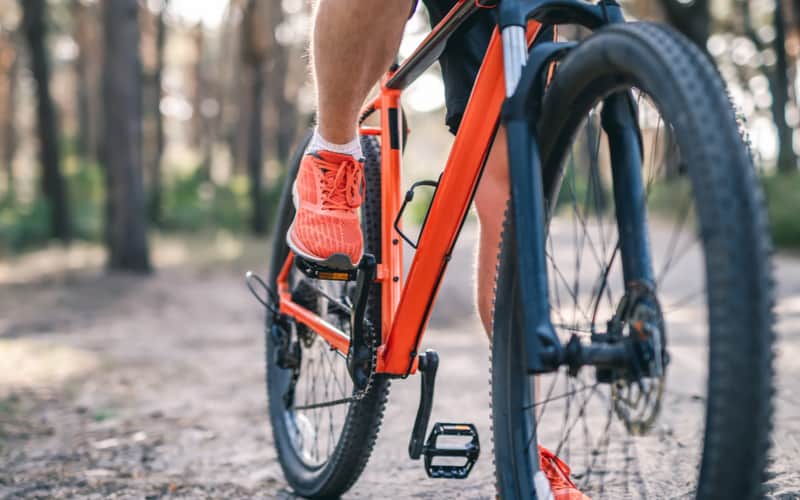You’ve been doing some online shopping lately and looking for new pedals for your trusty MTB.
You added a few to your cart and are about to make a final decision before checking out, but then you wonder, “are all mountain bike pedals the same?”
At the risk of spending money on pedals that will not fit your bike, you stop and head to Google for some answers.
Are mountain bike pedals universal? If not, how do you know which pedal size your mountain bike needs?
Keep reading to find out!
Contents
Are Mountain Bike Pedals Universal?
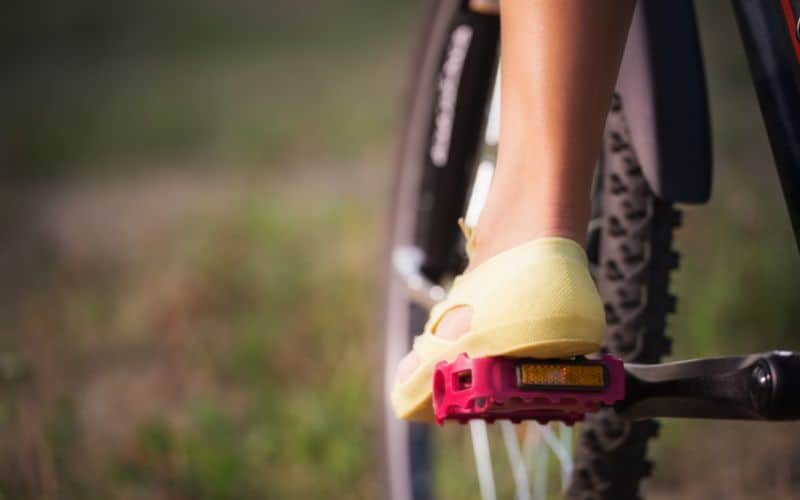
No, mountain bike pedals are not universal.
Although most high-quality mountain bikes will need a pedal with a 9/16 thread size, there are several budget mountain bikes that require a ½ thread size.
So, if you have an expensive bike, you will most likely need 9/16” pedals. However, if you have a simpler (and cheaper!) mountain bike, you may need ½” pedals.
It’s always better to be safe than sorry, especially when purchasing pricey pedals from the internet. So, we suggest you double-check your bike’s crank size.
How Do I Know What Pedal Size My Mountain Bike Needs?
Let’s learn how to tell which pedal size your mountain bike needs!
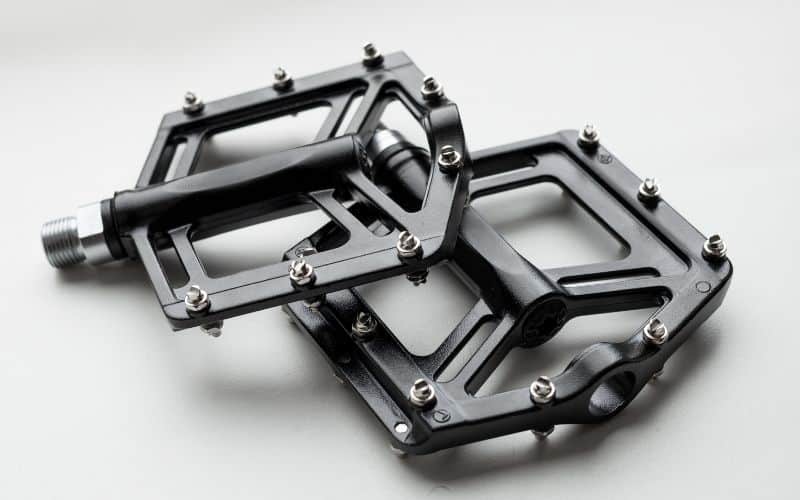
There are two ways you can find out which pedal size your bike needs. The first way is to look for the thread size engraved on the crank and the second is to measure the pedals using a digital caliper.
Take a look at your bike’s crank. You should see either 9/16 or ½ engraved onto it.
If you don’t see these numbers, check if your bike’s crank is made up of one or more pieces.
One-piece cranks, meaning all components are fused together, will usually need a ½ thread size.
Cranks made up of multiple separate pieces, which are usually found on high-end bikes, often use a 9/16 thread size.
If you’re having trouble distinguishing what type of crank your bike has and cannot find any numbers engraved on it, have no fear!
Find some pedals that you know fit your mountain bike and get measuring. To do this accurately, you will need a caliper. We prefer digital ones, like the Anytrp Digital 6 Inch Stainless Steel Caliper .

Make sure the caliper is set to fractions of an inch before measuring the pedal’s screw.
Now you can find out exactly which caliper size you need!
If you’re new to the world of thread sizes, watch the video below explaining the different thread sizes out there.
Different Types of Mountain Bike Pedals
There are two main types of mountain bike pedals: clipless and flat.
Ok, so now that you’ve got your pedal’s thread size sorted, you can start looking at specifics.
Here, the biggest decision you’ll have to make is if you want clipless or flat pedals.
Let’s go over these two types of mountain bike pedals, what they’re used for, and what you’ll need to use them.
Clipless Pedals
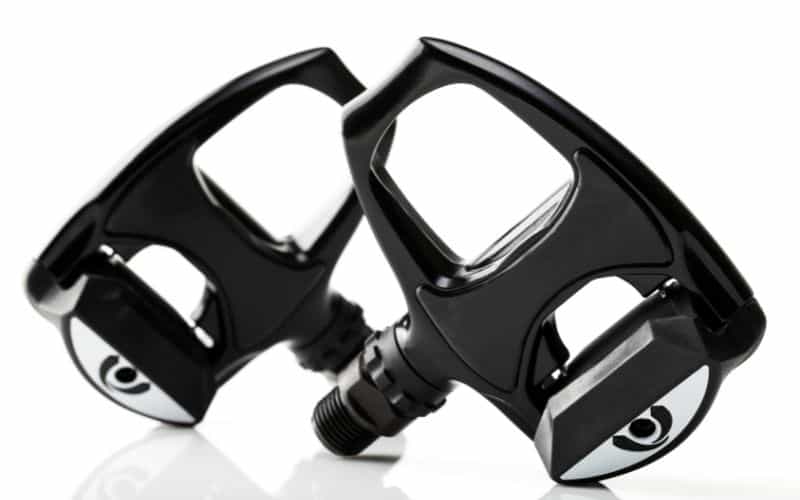
Clipless pedals clip onto your mountain bike shoes, fastening your feet to the pedal.
This is great if you love jumping and rough-riding since your feet won’t fly off the pedals.
It also makes pedaling easier, especially through very uneven surfaces, since you won’t have to exert more force to keep your feet on the pedals.
When jumping, you can also pull your bike up by the pedals, giving you more control of your height and angle.
However, if you’re relatively new to mountain biking, clipless pedals can be slightly dangerous since you won’t be able to hop off your bike as easily.
You will need to position your feet so that they unclip from the pedals, which takes a little practice and can be risky if done incorrectly.
You will also need specific shoes to use clipless pedals. These shoes have a thick sole and a small latching mechanism on the bottom.
This allows you to use your shoe’s hard sole as the pedal as it will clip to the lightweight clipless pedals.
Flat Pedals
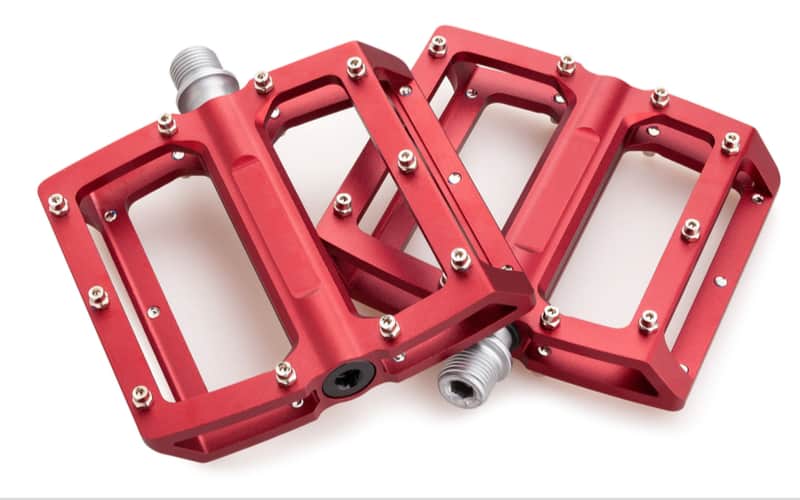
Are you a mountain biking amateur? If so, we suggest you stick to flat pedals.
Unlike clipless pedals which lock your shoe in place, flat pedals allow you to remove your feet from the pedals and jump off your bike if need be.
This is good if you like using your feet to balance yourself or enjoy knowing you can hop off your MTB if you’re about to crash or need to stop your bike if your brakes have suddenly given out.
Flat pedals are often fitted with small vertical screws, which can be made shorter or longer depending on your preferred traction. These help to keep your feet in place, while also allowing you to freely remove them if needed.
The great thing about flat pedals is that you can wear any shoes you want with them, and it’s actually beneficial for your shoe’s sole to be soft since you must curl your toes around the pedal.
However, keeping your feet on the pedals will require some extra energy, so you may find your calves and arms becoming tired quicker. This can be especially noticeable during long or particularly bumpy rides.
To learn more about clipless and flat pedals, their pros and cons, and which are the right fit for you, watch the video below.
What Should I Do If I Got the Wrong Pedal Size?
You can use a pedal thread adapter if you’ve bought the wrong pedal size.
Don’t throw out or return your ill-fitting pedals just yet!
You can use a pedal thread adapter to fit them to your bike’s crank.
These handy adapters fit onto your pedals’ screw, are easy to install, and are very affordable.
Just screw the adapters on your pedals, ensuring they’re securely fastened in place. If needed, you can use a wrench to make sure they’re tight.
Then screw your pedals onto your bike’s crank.
Our top pick for the best 9/16 to ½ adapter (i.e. for 9/16 pedals on a ½ bike crank) is the Hikenture Bike Pedal Adapter 9/16 since it’s made from rust-resistant metal and only weighs 6 grams.
If you bought ½ pedals for your 9/16 crank piece, check out the Mongoose Mountain Bike Pedal , which comes with ½ to 9/16 thread adapters.

Though this is a pedal and adapter set, it is very reasonably priced and many happy customers purchased it solely for the included adapter.
3 Good MTB Pedal Brands
If you’re on the hunt for some good MTB pedals, look no further!
When looking for solid MTB pedals, you need to make sure they’re high quality, adjustable, and have good traction to keep your feet in place.
Let’s go over some of our favorite MTB pedal brands to keep an eye out for the next time you go pedal shopping.
Crank Brothers

Most Crank Brothers pedals have between a 4.5 to 5-star rating on Amazon and their reviews speak for themselves.
Their flat pedals have great traction, but they’re best known for their clipless pedals, which are multi-sided to prevent the clip from getting clogged with mud. That means you’ll be able to use these come rain or shine!
This brand is slightly pricier than the others on this list, but if you’re looking for amazing clipless pedals, they’re well worth the money!
Shimano

How can you mention anything MTB related without talking about Shimano?
They have some solid flat pedals with adjustable pins that are simple to replace if needed. They also slope down in the middle, so your foot can sit firmly in place.
Shimano also has some competitively small, but sturdy, clipless pedals, which come with cleats. The best part is you can adjust the pressure, so beginners can ease their way into the world of clipless pedals and shoes.
They’re also long-lasting, so you don’t have to replace your pedals every couple of years, even if you’re an avid biker.
DMR
Black and silver pedals get the job done, but they couldn’t be more boring!
DMR offers a large variety of high-quality flat pedals in every color and design imaginable!
Their more affordable options do not have removable pins, though many of their pricier pedals do!
This allows you to carefully select which pedal is right for you based on how much traction you want, and your preferred material and size.
But they don’t just look pretty! They’re also grippy, solid, and the perfect choice for anyone building a bike on a budget!
Wrapping Things Up
Mountain Bike pedals aren’t universal, so it’s best to check what thread size your bike needs before making any purchases.
You should also consider the type of pedal you’d like to use depending on your riding style, experience, and footwear preferences.
Luckily, you can always buy a pedal thread adapter if you’ve already bought the wrong size of pedals for your MTB and can’t return them. Adapters are also a good option if you found some incredible pedals that aren’t the right size for your bike.
What’s your experience with mountain bike pedal sizing? Have you ever used a pedal thread adapter before?
Let us know in the comments below!
